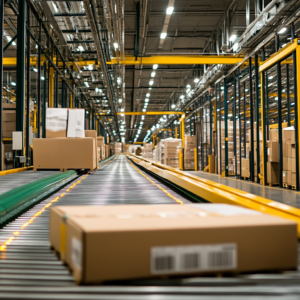The Midwest is a pivotal hub for logistics and warehousing due to its central location, extensive transportation networks, and proximity to major markets across the United States. The region’s infrastructure, including highways, expressways, railways, and waterways, offers unparalleled advantages for efficient supply chain management. Here are the top Midwest locations for logistics and warehousing distribution points, and the key highways, rail, and sea routes that make them ideal.

Chicago, Illinois: A Central Hub for Nationwide Distribution
Chicago is often regarded as the logistics capital of the United States. Its strategic location at the intersection of major interstate highways like I-90, I-94, I-55, and I-80 makes it an ideal spot for trucking and distribution. These highways provide direct routes to the East Coast, West Coast, and the South, facilitating nationwide distribution and minimizing transit times.
In addition to its highway network, Chicago is a major rail hub, with six of the seven Class I railroads serving the city, including Union Pacific and BNSF Railway. This extensive rail infrastructure enables efficient movement of goods to and from ports, manufacturing centers, and distribution facilities. Moreover, Chicago’s proximity to the Great Lakes and the Mississippi River offers additional flexibility for freight movement via water, connecting the region to international markets and boosting supply chain efficiency.
Indianapolis, Indiana: Optimal Connectivity for Supply Chain Management
Indianapolis is another prime location for logistics and warehousing, thanks to its central location and excellent highway connectivity. The city is at the crossroads of I-65, I-70, I-74, and I-69, providing easy access to more than 75% of the U.S. population within a day’s drive. This makes Indianapolis a strategic hub for companies looking to optimize their supply chains and reduce distribution costs.
Indianapolis is also well-served by rail, with CSX Transportation and Norfolk Southern operating major freight terminals in the area. The city’s Indianapolis International Airport, known for its extensive cargo operations, further enhances its appeal as a logistics center. The airport’s FedEx Express hub is one of the largest in the world, supporting overnight and just-in-time deliveries essential for efficient supply chain management.
Columbus, Ohio: Emerging Logistics Powerhouse in the Midwest
Columbus is rapidly emerging as a logistics powerhouse in the Midwest. Its central location, combined with a robust transportation network, makes it an attractive choice for warehousing and distribution. Major highways like I-70, I-71, and I-270 intersect in Columbus, providing efficient routes to major markets across the country.
The city is also well-connected by rail, with CSX and Norfolk Southern offering extensive freight services. Additionally, Columbus is within a short distance of the Port of Cleveland, providing access to international shipping routes via the Great Lakes. This multimodal connectivity enables businesses to optimize their supply chains and reduce transportation costs.
Kansas City, Missouri: Strategic Crossroads for National Distribution
Kansas City is a key logistics hub in the Midwest, strategically located at the intersection of major highways such as I-70, I-35, and I-29. These highways connect Kansas City to major markets across the U.S., including the East Coast, West Coast, and the South, making it an ideal location for distribution centers.
Kansas City also boasts a robust rail network, with major freight railroads like Union Pacific and BNSF operating in the area. The city is one of the largest rail centers in the U.S., offering extensive intermodal facilities that streamline the transfer of goods between rail and road. Additionally, the Port of Kansas City on the Missouri River provides access to barge transportation, further enhancing the region’s logistics capabilities.
The Midwest offers several prime locations for logistics and warehousing distribution points, each with unique advantages. Chicago, Indianapolis, Columbus, and Kansas City stand out due to their strategic locations, extensive highway networks, and robust rail and waterway connections. These cities provide businesses with the infrastructure needed to optimize their supply chains, reduce transportation costs, and efficiently distribute goods across the United States and beyond. Choosing the right Midwest location can significantly impact the efficiency and cost-effectiveness of a company’s logistics operations.